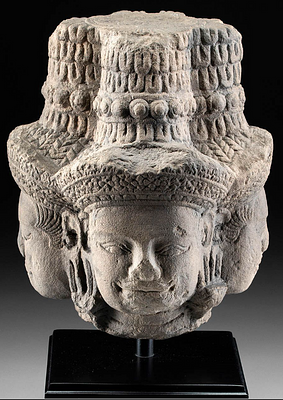Fine Aztec Stone Serpent / Quetzalcoatl
Lot 112a
About Seller
Artemis Gallery
686 S Taylor Ave, Ste 106
Louisville, CO 80027
United States
Selling antiquities, ancient and ethnographic art online since 1993, Artemis Gallery specializes in Classical Antiquities (Egyptian, Greek, Roman, Near Eastern), Asian, Pre-Columbian, African / Tribal / Oceanographic art. Our extensive inventory includes pottery, stone, metal, wood, glass and textil...Read more
Categories
Estimate:
$10,000 - $15,000
Absentee vs Live bid
Two ways to bid:
- Leave a max absentee bid and the platform will bid on your behalf up to your maximum bid during the live auction.
- Bid live during the auction and your bids will be submitted real-time to the auctioneer.
Bid Increments
| Price | Bid Increment |
|---|---|
| $0 | $25 |
| $300 | $50 |
| $1,000 | $100 |
| $2,000 | $250 |
| $5,000 | $500 |
| $10,000 | $1,000 |
| $20,000 | $2,500 |
| $50,000 | $5,000 |
| $100,000 | $10,000 |
| $200,000 | $20,000 |
About Auction
By Artemis Gallery
Jun 29, 2023
Set Reminder
2023-06-29 10:00:00
2023-06-29 10:00:00
America/New_York
Bidsquare
Bidsquare : Exceptional Antiquities, Ethnographic and Fine Art
https://www.bidsquare.com/auctions/artemis-gallery/exceptional-antiquities-ethnographic-and-fine-art-13031
Artemis Gallery info@artemisgallery.com
Artemis Gallery info@artemisgallery.com
- Lot Description
Pre-Columbian, Central Mexico, Aztec, ca. 1325 to 1475 CE. A hand-carved stone serpent of exquisite form and expert skill that is coiled atop itself with the head and segmented tail meeting on top. Bulging eyes, thick lips, a raised snout, protruding fangs, and a forked tongue all create the reptilian visage, and deep grooves across the body give the serpent a dynamic sense of movement. Perhaps depicting Quetzalcoatl, the mythical serpent, this snake provides a fascinating illustration of Pre-Columbian iconography given its association with power, rebirth, transition, and renewal. Since snakes shed their skin annually, thus rejuvenating themselves, the ancients of Mexico viewed them as providing hope for the possibility of change in the face of adversity. Size: 10.25" L x 6.625" W x 6.7" H (26 cm x 16.8 cm x 17 cm)
A pair of Aztec stone serpents can be found at the Metropolitan Museum of Art, 1 nearly identical under accession number 1979.206.477 and the other with its mouth closed under accession number 00.5.32. The curator's description of 00.5.32 points to other serpents depicted in ancient Mexican visual culture, "At the Main Temple in the Aztec imperial capital Tenochtitlan, serpent depictions proliferate: monumental snake heads, probably representing different species - with open fanged mouths and forked tongues - flank braziers and stairways leading to the sanctuaries. The temple itself is said to have been surrounded at the time of the Spanish conquest by a serpent wall, or Coatepantli, formed by hundreds of adjoining sculptures of snakes."
This serpent form represents Quetzalcoatl - "Feathered Serpent" in the Nahuatl language - the Pre-Columbian deity revered as lord of wind and sky. The earliest representations of Quetzalcoatl adorn the Temple of Quetzalcoatl in Teotihuacan, Mexico (ca. 3rd century CE) where numerous stone heads of the divine plumed snake embellish the steps of this Pre-Classic pyramid. The pioneering artist/anthropologist Miguel Covarrubias whose writings and illustrations on indigenous cultures of the ancient Americas continue to contribute to scholarly studies today stated, "Quetzalcoatl stood for all that was good in this world: peace, art, wisdom, and prosperity. Disguised as an ant, he discovered maize, the staple food of the Indians, hidden under the mountain of Substance, Tonacatepetl; he also invented the arts, the sciences, and the calendar. In fact, everything connected with wisdom and culture was attributed to Quetzalcoatl." (Miguel Covarrubias, Mexico South: The Isthmus of Tehuantepec (New York: Alfred A. Knopf, 1946), 130)
Cf. The Vilcek Foundation, accession number 2003.01.1
This item is heavy/oversized and will require 3rd party shipping. Please inquire about shipping cost prior to bidding.
Provenance: private Lexington, Kentucky, USA collection; ex-Dr. Milton M. Birnbaum collection, 1969
All items legal to buy/sell under U.S. Statute covering cultural patrimony Code 2600, CHAPTER 14, and are guaranteed to be as described or your money back.
A Certificate of Authenticity will accompany all winning bids.
We ship worldwide and handle all shipping in-house for your convenience.
#179735Nicks and abrasions commensurate with age, with light amount of surface infill on some rough areas, and minor earthen deposits, otherwise intact and excellent. Wonderful preservation to form and finer details.Condition
- Shipping Info
-
All shipping is handled in-house for your convenience. Your invoice from Artemis Gallery will include shipping calculation instructions. If in doubt, please inquire BEFORE bidding for estimated shipping costs for individual items.
-
- Buyer's Premium



 EUR
EUR CAD
CAD AUD
AUD GBP
GBP MXN
MXN HKD
HKD CNY
CNY MYR
MYR SEK
SEK SGD
SGD CHF
CHF THB
THB














